Old Fashioned Currant Jelly Recipe – No Added Pectin
This post may contain affiliate links. Read my full disclosure here.
If you’re lucky enough to have a patch of currants in your garden—or a friendly neighbor who shares—this currant jelly recipe is a delicious way to capture their unique tart-sweet flavor. We’ll show you how to make jelly with either red, black, or white currants – no store-bought pectin required.
This homemade currant jelly recipe starts with a pint of currant juice (or more) and sugar. You don’t need commercial pectin. I sometimes add almond extract to switch up the flavor, but it’s good with or without.
If you’d like a currant spread recipe that uses less sugar, see “Apple Currant Spread“. I’ve also experimented with currant blends, like this Queen Anne’s Lace Jelly with Currants. Currants also blend wonderfully with raspberries, enhancing the raspberry flavor.
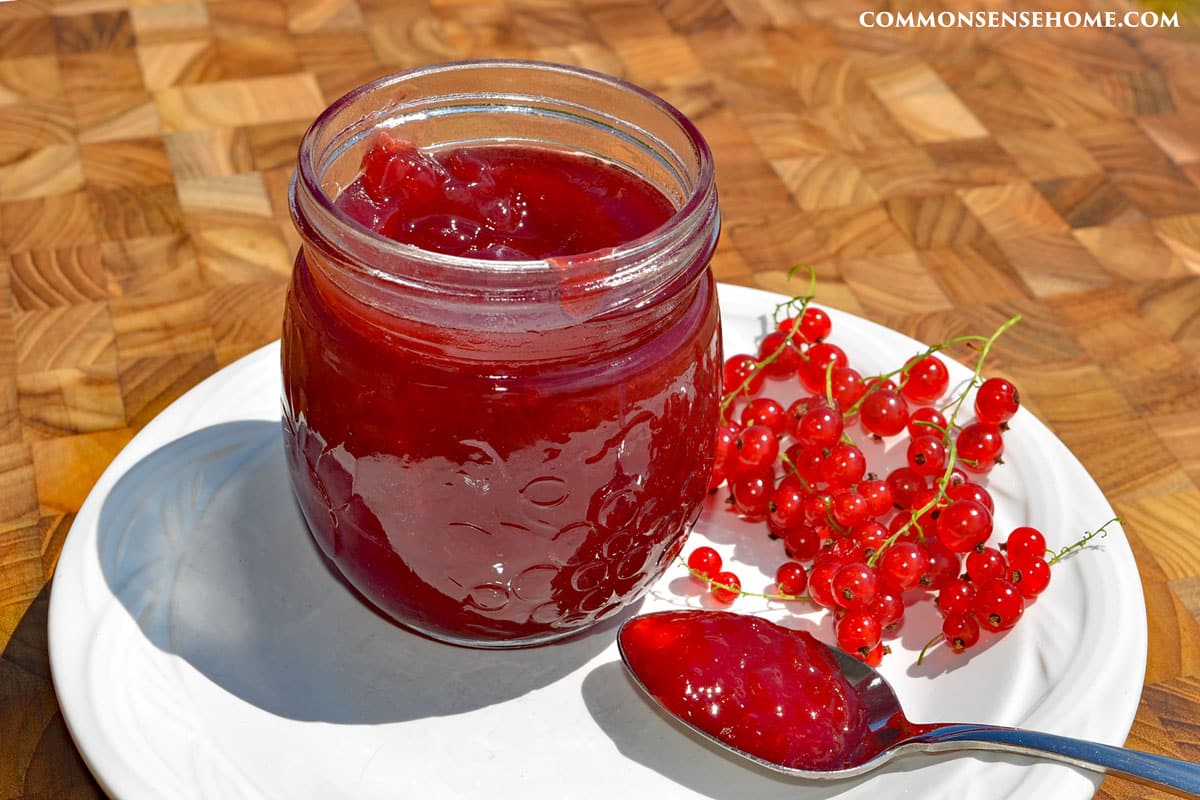
Table of Contents
Grandma’s Lost Currant Jelly Recipe
I think God has a funny sense of humor. I was thinking last weekend, “Hmmm, I wonder if my neighbor will have any extra currants this year. It wouldn’t be too bad if she didn’t as I am quite busy enough already.”
Said neighbor called later the same day. She had a bumper crop of currants, and asked if would I like to come over and pick some.
The neighbor who shares her currants (Betty), told me that her grandmother used to make currant jelly without using added pectin. She remembered years ago when her grandma sent the grandkids to pick the currants. When they came back in the house with berries, grandma was steamed!
You see, the secret to her jelly was using the stems to provide extra pectin. Without the stems, the jelly takes longer to gel. Betty had lost her grandmother’s recipe, but remembered the jelly fondly.
Note: We relocated the neighbor’s currant plants to our yard in 2021 since they were downsizing. You can read more at “Currants – Growing, Harvesting, and Uses“.
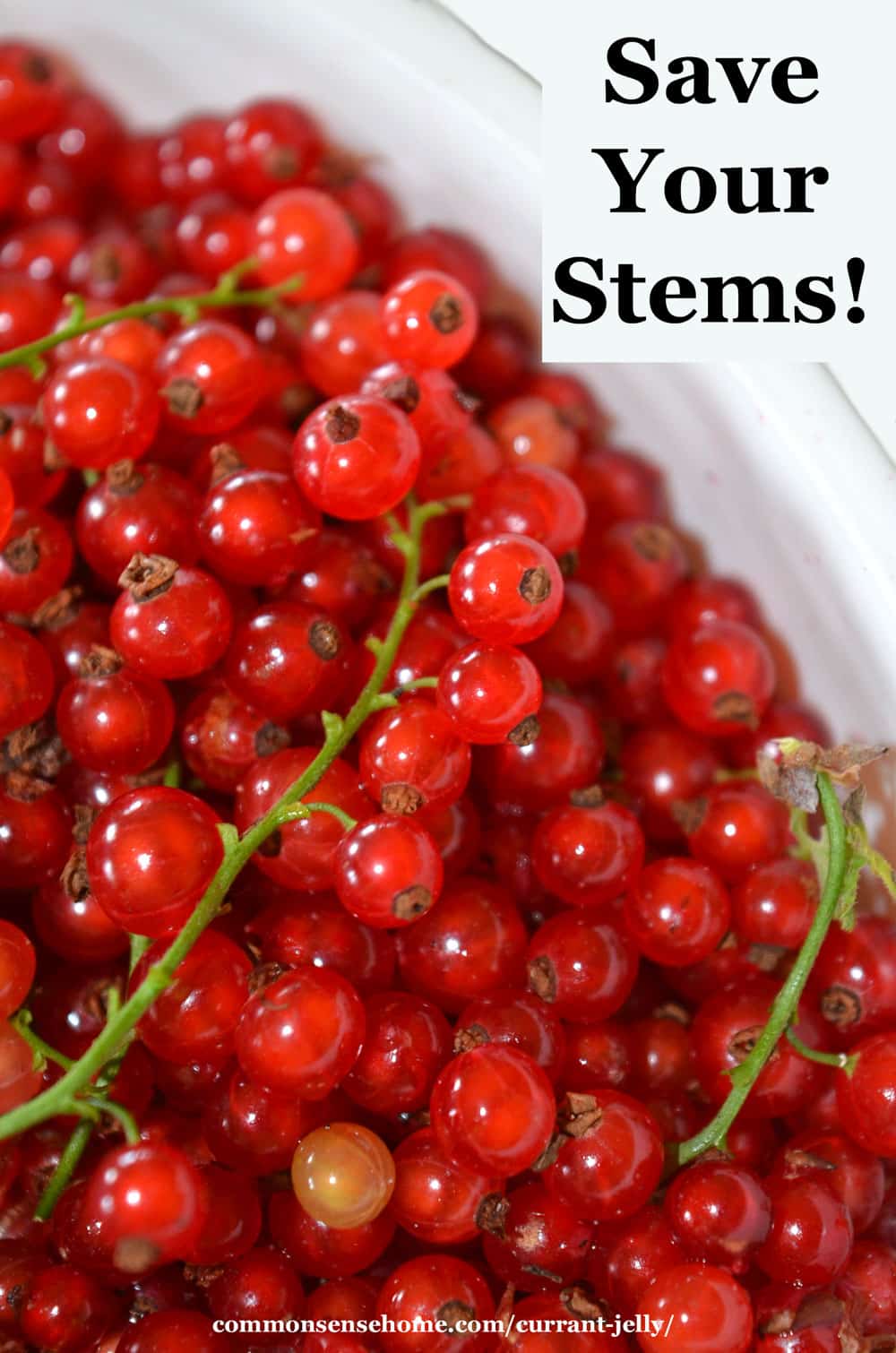
Over the years, I’ve been building my recipe library, and I have a book called Jams and Jellies by May Byron. It contains 543 recipes for just about every type of jam, jelly, and preserve that you can imagine.
Some of the recipes are a couple hundred years old. (For instance, one recipe calls for using a spaddle to put berries in your hair sieve after cooking them over the fire). This recipe was from the book, adapted for current canning guidelines.
This recipe is safe for a water bath canner or steam canner. You can use red, black, pink, or white currants. If you’re making a half batch, you can store it in the refrigerator and skip canning.
How to Make Currant Jelly – Step by Step
We start with the mounds of clean berries – a lot of berries. These currants are about the size of peas, so we probably had over a thousand of the little buggers. You’ll need around 5 pounds of red currants to get 4 cups of prepared juice.
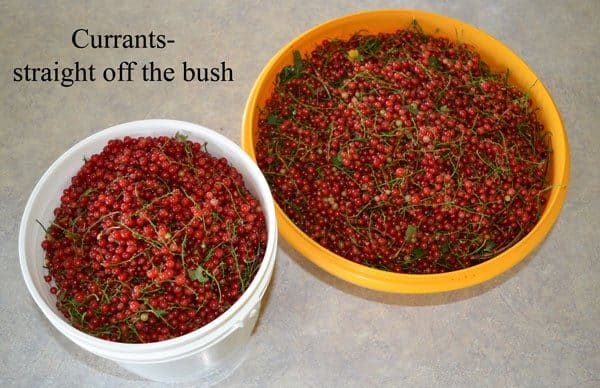
It’s okay to scale the recipe up or down to use the berries that you have available. Smaller batches will gel faster, larger batches take longer to cook. We picked out leaves and debris and rinsed the berries well.
Preparing the Juice for Jelly
I smashed the currants with a potato masher and cooked them down in two heavy-bottom pots. You can add a little water if you like to help prevent scorching.
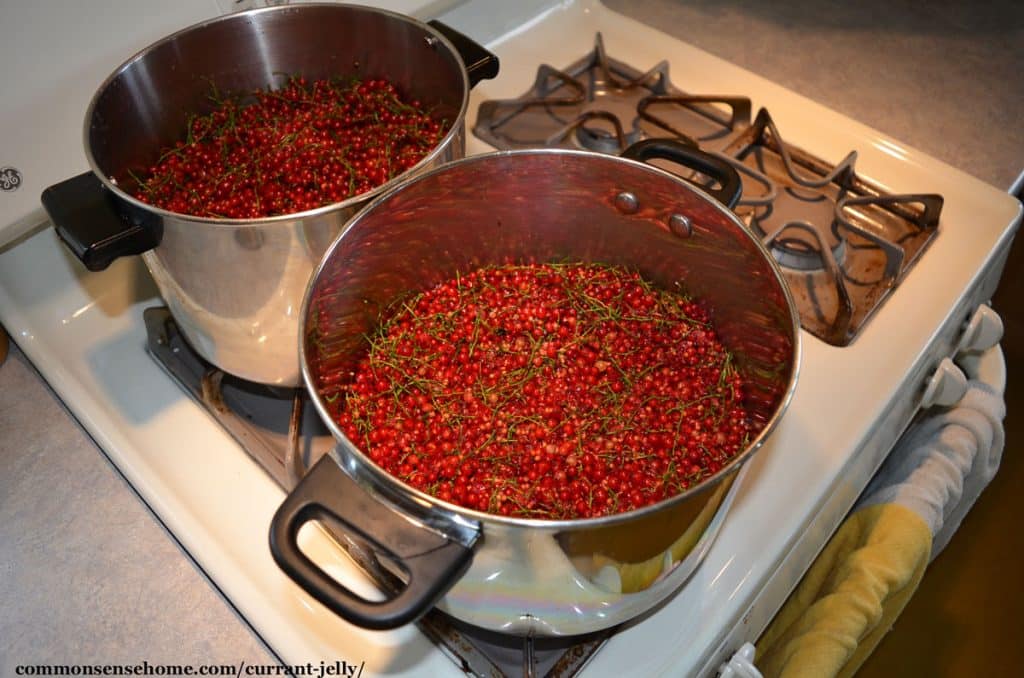
I have a jelly bag and stand, but this batch called for something a little larger. I tethered an old pillowcase to a cabinet handle, shoveled in the red stuff, and we were in business. Here are the two drip devices in progress sitting next to the initial juice runoff.
You could also use sturdy cheesecloth or a flour sack towel. I let them drain for a couple of hours. It seemed most of the juice was out, as the flow had slowed to barely a trickle.
Would you like to save this?
Straining the berries keeps the juice clear for a prettier jelly. If you’re in a hurry and don’t mind some pulp, you can use a food strainer to remove the stems and seeds.
Making the Jelly
Measure the juice, then determine how much sugar you need based on the amount of juice. For each pint of juice, measure out one pound of cane sugar. (1 pound of granulated sugar is roughly 2 1/4 cups of sugar.)
Examples:
- 1 pint juice = 2 1/4 cup sugar
- 1 cup juice = 1 cup + 2 Tablespoons sugar
- 1 quart juice = 4 1/2 cups sugar
It’s okay to add a small amount of water or a different juice (like apple) to help get an even amount.
Prepare canning jars, lids and water bath canner. In large, heavy bottom stockpot, boil juice for 10 to 20 minutes, until it starts to thicken and gel.
About ten minutes of boiling seems to be enough (although 20 would certainly give a firmer product). The National Center for Home Food Preservation gives more specific guidelines for gel testing. I just stir and watch for the gel.
Add the sugar and stir constantly until dissolved. Continue stirring until mixture reaches a rolling boil. Boil over high heat for one minute. Remove from heat and add almond extract, if desired.
The kitchen started to look like a crime scene as the night progressed.
Fill jars, leaving 1/4 inch headspace. Wipe rims and place two piece lids. Process in a water bath canner for 10 minutes. Remove jars from canner and place on a cloth out away from drafts.
Our final product – 10 jars of currant jelly and currant almond jelly. Allow to cool completely or overnight.
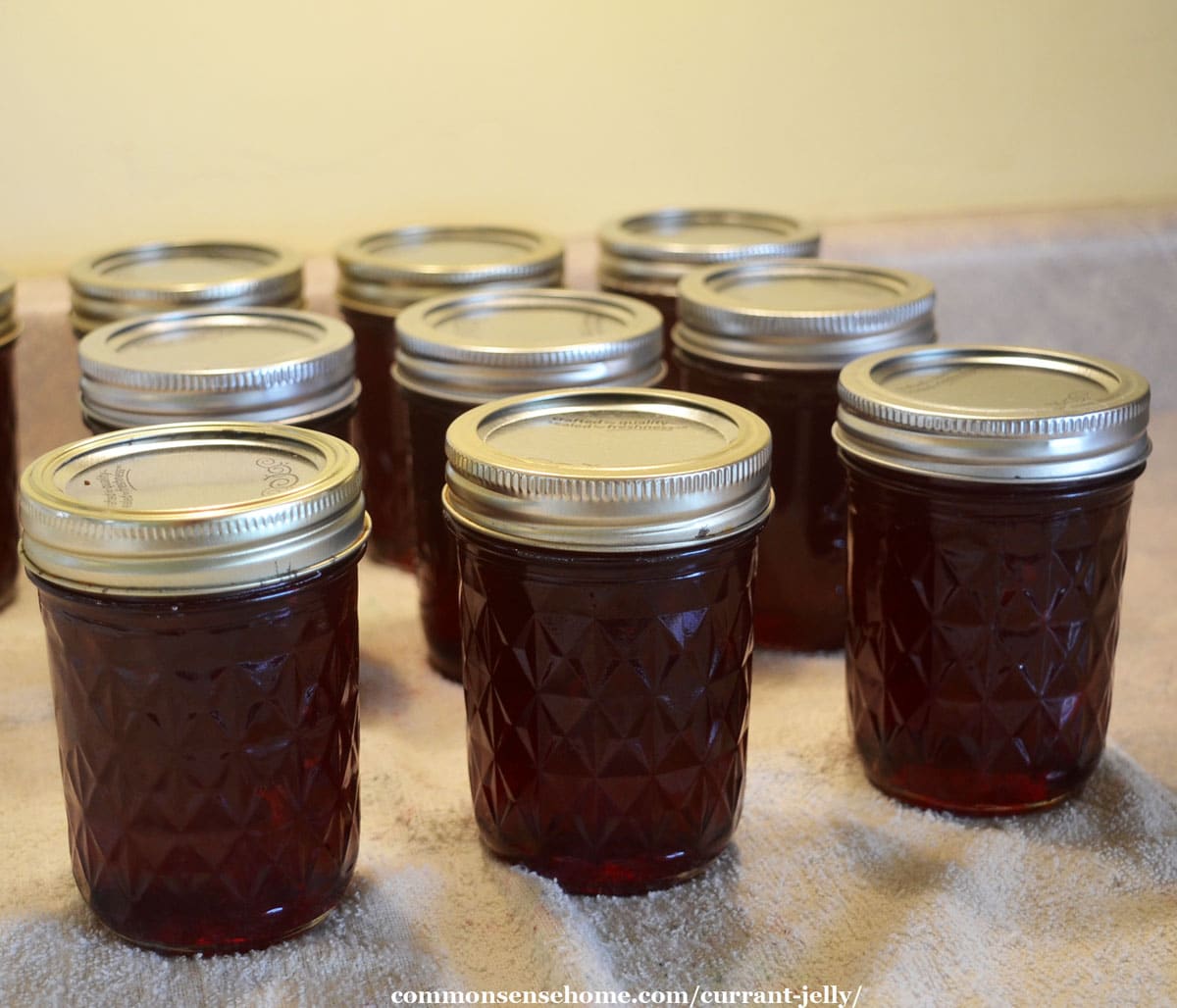
In the morning, the rings come off, and the jars get a quick wipe for any spills. I use a Sharpie marker to write the name and date on the lid. You can use stick on labels, but a Sharpie is the quickest, easiest thing I’ve found to date.
We store the sealed jars in the basement pantry, which is cool and dark. For best quality, use within 2 years. As long as the seal is intact, it’s safe to use.
PrintEasy Red Currant Jelly
Easy two ingredient currant jelly is perfect for beginning home canners.
- Prep Time: 30 minutes
- Cook Time: 30 minutes
- Total Time: 1 hour
- Yield: 3 cups 1x
- Category: Jelly
- Method: Canning
- Cuisine: American
Ingredients
- For each pint of red currant juice, use 1 pound of cane sugar
- Almond extract (optional)
Instructions
- Wash currants, removing leaves and debris but leaving stems intact. Put currants in large stock pot and simmer on low heat, smashing occasionally, until soft.
- Place cooked currants in cheese cloth or strainer to drain for several hours, preferably overnight.
- Measure juice. For each pint of juice, measure out 1 pound of cane sugar. Set sugar aside.
- Prepare canning jars, lids and water bath canner.
- In large, heavy bottom stockpot, boil juice for 10 – 20 minutes, until it starts to thicken and gel.
- Add sugar all at once. Stir constantly until sugar is dissolved. Continue stirring until mixture reaches a rolling boil. Boil one minute.
- Remove from heat. Add almond extract, if desired. (One teaspoon per pint of juice, or to taste.)
- Fill jars to 1/4″ headspace. Wipe rims and place two piece lids. Process jars in a water bath canner for 10 minutes.
- Remove jars from canner and place on a cloth out away from drafts. Allow to cool completely. (Overnight is good.)
- Remove rings and double check seals. Wipe up any spills. Label jars and store in a cool, dry location out of direct light.
Notes
Quality is best if used within two years of processing. Once jar is opened, refrigerate uneaten portions and use within a few weeks. Nutrition information is estimated for a yield of 3 cups of jelly from one pint of juice.
One pound of granulated sugar is roughly 2 1/4 cups. Measure your juice, then decide how much sugar you need.
Nutrition
- Serving Size: 1 tablespoon
Frequently Asked Questions
What does currant jelly taste like?
Currant jelly has a sweet tart flavor similar to cranberry sauce. Sweet tart and simple to make, this old fashioned currant jelly will brighten any pantry.
How do you use currant jelly?
It works well with meats and cheeses. It’s quite yummy spooned over a nice baked Brie. It’s also lovely with pancakes, toast, or mixed into yogurt. You can use it for filling thumbprint or ribbon cookies, or your favorite layer cake.
Can you eat raw red currants?
Yes, it’s perfectly safe to eat raw red currants, or pink or black currants. I used to nibble them off of my grandmother’s currant bush all every year. They are, however, quite tart, so most people add sugar.
Why is red currant jelly so hard to find?
Some states ban growing currants, and the berries are labor intensive to pick, and don’t travel well. Modern eaters often choose sweeter fruit, and don’t appreciate the old fashioned flavor of tart redcurrant jelly.
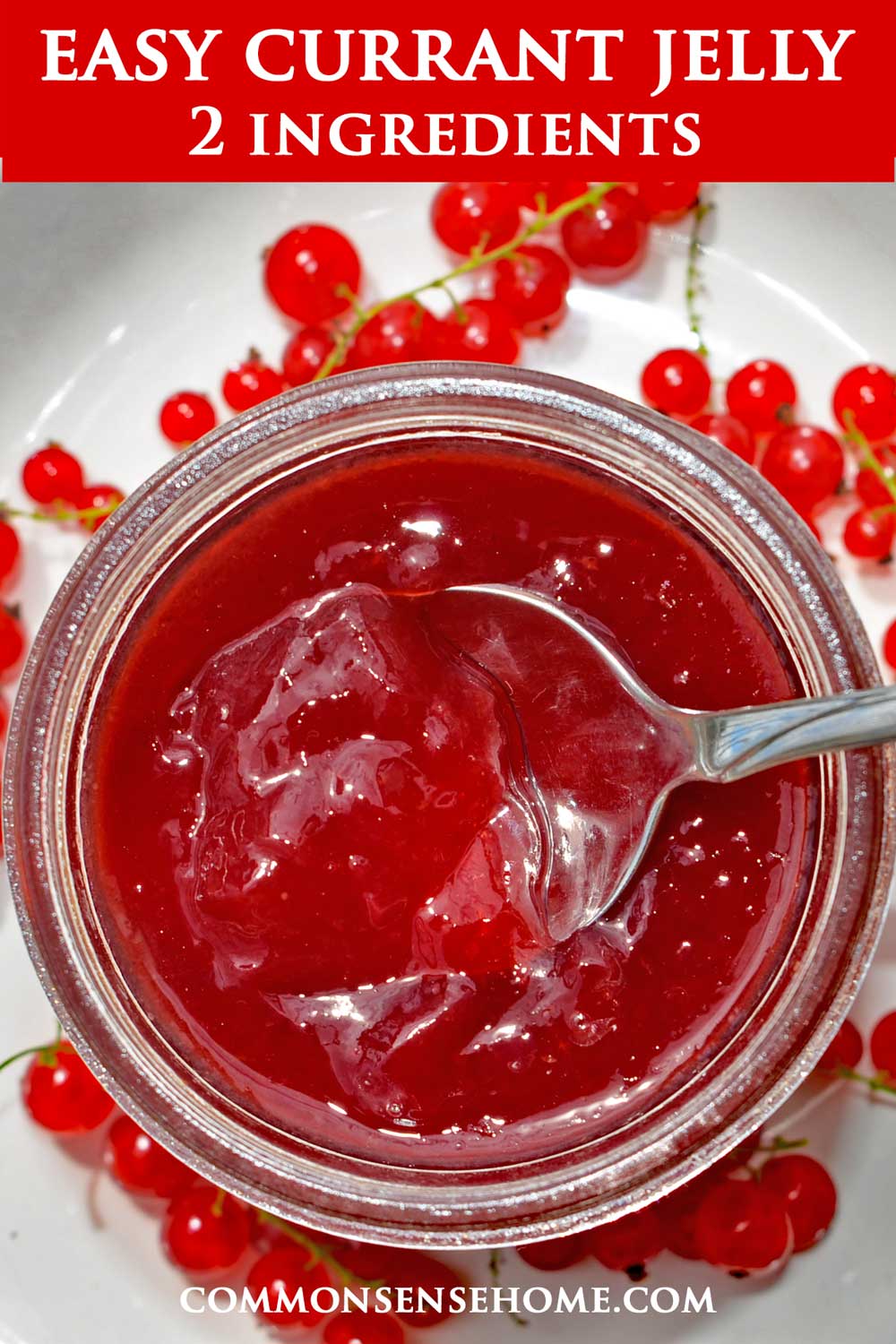
More Made from Scratch Recipes
- Currant Scones
- 13 Homemade Bread Recipes (to go with your jelly)
- Elderberry Jelly Recipes – Low Sugar and Sure-Jell Options
- Corn Cob Jelly – Traditional and Low Sugar

This article is written by Laurie Neverman. Laurie grew up in the kitchen, learning baking and home cooking from her momma. At age 15, she and her mom and two sisters created Irene’s Custom Cakes & Catering. This was her summer job through most of high school and college.
Now she combines old and new recipes and garden fresh produce to make tasty, easy to prepare foods. Along with her passion for growing nutrient dense food, she also enjoys ancient history, adorable ducks, and lifelong learning.
Originally posted in 2009, last updated in 2025.

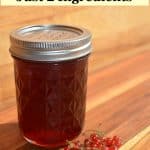
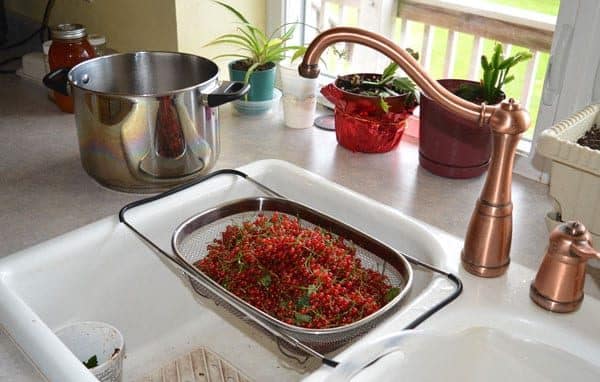

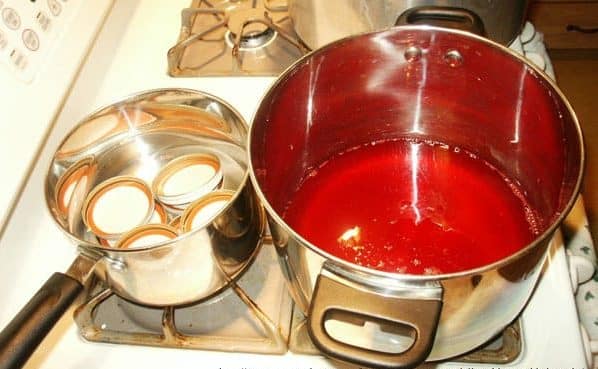
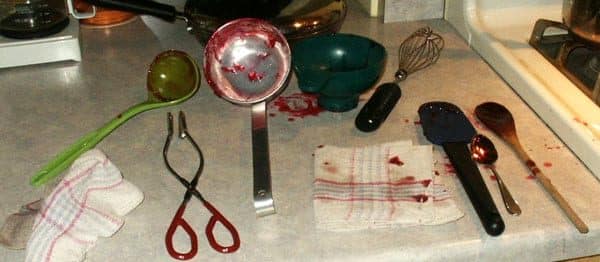
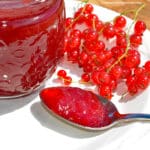
I tried this recipe yesterday. (I found this recipe didn’t make as much as I was expecting because you do not add any water.)
I am not sure if the recipe could be altered because I found it confusing that instead of using cups of juice and cups of sugar required to make this recipe, it is based off of pounds. I think I may have messed up the recipe as a result. :(.
So please correct me if I am wrong. But I googled *1 pound of granulated sugar = approximately 2 1/4 cups of sugar.*
Google also says that *1 pint = 2.4 cups. *
So to make this recipe understandable for me I think the recipe would be more accessible (for newbies like me at least…) if it read:
Does that mean for every cup of berry juice you add a cup of sugar?? Man that would have made sooo much more sense to say it that way, at least for me.
-Another point, is this recipe safe if the stems are omitted from the recipe?
The recipe was adapted from an old cookbook that used sugar by weight. It would technically be one cup and one tablespoon of sugar per cup of currant juice, but one cup would likely be close enough.
The recipe is perfectly safe if the stems are omitted, but the stems contain much of the pectin, so it may not gel as well. Safety of water bath recipes is based on the pH of the product being canned. Only acidic products with a pH of 4.6 or lower are suitable for water bath canning.
It’s okay to add a little bit of water to your currants when they are cooking down so that they are less likely to scorch, but you don’t want to add a lot of water. Too much water would dilute the juice and make it less likely to gel.
I followed your recipe exactly. My currants did not make juice, more the consistency of catchup and had an unpleasant smell when cooking. The jelly tasted good but had a bitter finish. Any ideas why? I thought maybe the fruit wasn’t quite ripe.
Maybe the fruit was underripe, or maybe your stove top burner runs hot and overcooked the fruit and stems? The stems are somewhat bitter, so a gentle heat is recommended, not boiling, which may bring out the bitterness. This may also have contributed to your jelly being cloudy instead of clear.
How did you get the juice out of the currants? If you want a clear juice, you need to use something like a flower sack towel, several layers of cheesecloth, or a jelly strainer. It must also be left to drain without squeezing, or you’ll get pulp in the jelly, which will make it cloudy instead of clear. Using a food mill, mesh strainer or chinois to juice the fruit will also leave it thicken and more cloudy.
I make a mixed berry jam and add currants for their wonderful tartness and acidity. I never have to use pectin.
What else can you add to the jelly to make it spicier.
You should be able to convert it to a currant pepper jelly by adding 1/2 cup to 1 cup finely diced hot peppers near the end of the boiling period. It would be best to double check pH and add extra acid if needed to keep the pH at 4.6 or below for safe water bath canning. As a precaution, you could add 2 to 4 tablespoons of lemon juice along with the peppers.
what is the best sugar free Recipe
Currants are so tart that some sort of sweetener is needed to make them palatable. If you don’t add sugar, you’ll need some sort of commercial pectin. I have a recipe on the site that is much lower in sugar at https://commonsensehome.com/apple-currant-spread/
If you wanted to make it sugar free, I’d swap out the sugar for xylitol.
Can this be made on a much smaller scale? And can it be made with organic stevia instead of sugar? If so how would you adjust the recipe? Thanks in advance for your help!
You can adjust the amount of juice as long as you adjust the proportion of sugar in the same way.
No, this recipe cannot be made with stevia instead. Sugar acts as a preservative, binding up free water and inhibiting bacteria growth. It also helps the juice to gel.
If you’d like to make a sugar free currant jelly, I’d highly recommend picking up a pack of Pomona’s Pectin (you can order it online here) and following their directions. With Pomona’s Pectin, you can use your sweetener of choice, or no sweetener at all. One box makes several batches of jam or jelly.
I don’t use the pectin recipes as they don’t allow enough room time for all the particles to bring themselves to the surface to be skimmed off. I use just juice and sugar.
I have made currant jelly for years and I always squeeze the pulp as hard as I can. The yield is greatly increased, seems more flavorful, and the tiny particles come to the surface as foam as it cooks with the sugar. I simply skim it off and my jelly is always crystal clear.
I didn’t notice a significant change in yield from simply letting the towel drip overnight or several hours. For me it’s easier not to squeeze and then skip skimming.
I have a question : Will the juice gel if I put less sugar in it ? Made it years ago and can’t remember how much sugar I used.
I like jelly on the tart side.
It may not gel without added pectin if you cut the sugar, although I haven’t tried it. If it doesn’t work, there’s always syrup, or you could recook with added pectin.
Why do so many people spell this fruit incorrectly? It is CURRANT not CURRENT. Thank you for letting me vent!
This is exciting. I have three black currant bushes and one red one. They are all newly planted but the red one has fruit. I doubt that there will be much more than a half pound of berries this year but watch out for next year and the following ones. I remember this recipe for a sauce for roast or grilled chicken that requires red currant jelly, an ingredient that is damned hard to find in the store. Thanx, so much!
Regarding earlier questions/comments of yields. I started with 16 lbs of fresh currants from my garden. I have three mature bushes which I picked nearly completely including some less than fully ripe currants. Under ripe fruit adds to the tartness and has a higher natural pectin content.
Gave me 14 cups of juice, 7 pints, 112 oz of clear juice filtered through a clean pillow case.
Boiled the juice with 7lb of cane sugar for 15 minutes, was more than enough to gel perfectly without added pectin. Sugar and juice were mixed and boiled together.
This yielded 18-8 oz and 4-12 oz jars of beautiful clear currant jelly which has a hyper intense flavor.
Additionally I salvaged a little less than 4 cups of thick pulpy semi solids by processing the leftovers that didn’t pass through the pillowcase filter in a Foley Food Mill . These I will use to make delicious Currant Vinaigrette salad dressing.
Great recipe !
Thanks for sharing your experience, Ron.
My mother made currant-apple jelly 50+ years ago so I have experimented with your recipe adding some chopped up apples (seed removed) during the first “cooking phase” with great results. The jelly isn’t quite as clear but tastes great. Apples have natural pectin and I had already stemmed my currants.
Also, the currants make wonderful tarts and pie. My own children and grandchildren love currants as a result.
I love currants and apples together. It’s a nice mix of sweet and tart. Your children and grandchildren are lucky to have you to help them appreciate this underused fruit.
I am going to try this this year, but my question is does the jelly ever taste bitter or Barky to anyone. I’ve been told the stems can give it that flavor. It’s still not going to stop me from trying I was just wondering what everyone’s opinion was. 🙂
I haven’t found it to be bitter, and I’ve been making it this way for several years.
Just a little tip for those still using jelly bags – new knee high nylon stockings make awesome jelly bags and they’re cheap! Just place in your juice collection pot and stretch the knee band to grip around the top and treat just as your usual jelly bag. The beauty of using these is, once your juice has all dripped out, you can simply toss everything, knee high included, in the trash, or invert the knee high to compost the contents, rinse the knee high well and reuse.
Are those safe to be in contact with hot food? Many types of synthetics give off chemicals at high temperatures. I know when we had the family catering business, all plastics in contact with food had to be food grade, i.e., specifically rated for safety in contact with food.
I bought a red current bush, about 5 years ago, thinking my kids would love the berries…my youngest (6) does–when they’re green! He does get into that bush and snacks on as many as will fit into his mouth, again and again!
This year, I had such a bumper crop, my mother-in-law suggested current jelly. I’ve picked my bush clean today and tomorrow I start the process. I’m so excited–I love canning. I’m glad I came across your recipe before I de-stemmed them!! Thank you!
Oh my – I’ve never heard of anyone enjoying them green. Enjoy your jelly!
Laurie, I misread the directions and added the sugar right away without boiling the juice first….is this still salvageable? Can I continue boiling and adding the almond extract and then canning it???
Thanks,
Kristina
Only one way to find out for sure…. I would think it would work.
Yes, it will work. Just continue boiling until the syrup reaches the ‘jelling’ point, then add the almond extract.
Laurie you are amazing! We recently moved to Idaho, and we discovered 3 strange bushes in the back yard. Coming from Phoenix we’d never seen anything like it. So took a sample to a nursery, where 3 people finally concurred we had 2 black and one red current bushes! WOW, so now what does one do with them? No one had an answer, until I started getting you e-mails and today was the awakening I’d been waiting for!
Eating them alone is very bitter, so we left them for the birds.
Thank you!
You’re welcome. You can also pair them up with other juices (like pear or apple) to make a milder jelly.
I like tart foods, so I don’t mind eating them straight off the bush, even with the level of pucker power. It’s probably because of the bush my grandmother had when I was a little girl. Good memories.
Using a steamer juicer means you can get the juice (crystal clear) AND make the jelly in a single morning.
That’s great if you have one available.
Hi is this Meredith Seal?
When you put the jars with the juice in the water bath does it need to boil for 10 minutes or just sit
in the water
Boil for 10 minutes, thus the term, “boiling water bath canner”.
A spadle is a Scotish wooden spatula. It existed long before Tupperware came into existence. Since learning about it, I have wanted one. They look easy enough to make.
One question: what does a Current Bush/tree/plant look like? Think my neighbour has one…
Cheers. Good job.
Here’s a shot of some of branches of one we were picking. The place we’ve been visiting has a clump about 5 feet tall and eight feet across. My grandmother’s bush was much smaller.
Love this recipe. I used blackcurrants I got through a local CSA. So easy to make and the taste took my right back to my childhood and my grandmother’s kitchen.
I haven’t had access to black currants since we moved away from our last home. Yum!
one of my favourite jellies is a spiced red currant jelly that uses pectin, I will need to see if I can combine the spices of that one with this idea. Love the idea of not needing to remove every little stem.
Dear Laurie
Many thanks the v helpful website. Now I am a granny may I add 3 things?
1 Mashing the fruit isnt such a good idea as it can make the glorious juice cloudy, tho I see Laurie’s is beautifully clear. Provided the currants are cooked till the skins are softened, straining through the muslin overnight gets all juice out.
2 Heating the sugar is a good idea as it cuts down the cooking time, which of course means less loss of flavour
3 My constant guide is Constance Spry, a thorough, totally reliable woman. She explains why you do things and has cures for what goes wrong. She ran a first class finishing school in Ascot for many years. You’re lucky if you can find her large pink, cookery book second hand
As long as you don’t squeeze the bag when straining, there shouldn’t be a problem with cloudy jelly, even when the berries are mashed (as you can see from the photos).
How do you heat your sugar? In a pan on the stove? In the oven? My kitchen tends to get pretty warm when canning, and of course the juice is piping hot when the sugar is added, so I’ve never had an issue with the flavor on this jelly, unlike some boil down jellies I’ve tried that tend to taste a little more “cooked” than I prefer.
I haven’t heard of Constance Spry, but I’ll have to keep an eye out at the book sales and thrift stores. I love good food preservation and recipe books.
i am curious, you never said how much sugar to add per pound of currants, or how much of the currant juice you had after the currants were drained in the jelly bag, please do tell. Thanks so much!!!
The recipe specified one pound of sugar for every pint of juice. I’m not sure how many pounds of currants are needed for a pint of juice, I just measured the juice and then measured the sugar accordingly. I haven’t made this in the while since the neighbors sold the property with the main currant bushes, so I can’t remember specifically how many pints of juice I had for this batch.
Does that wonderful book have a recipe for rhubarb, banana, almond jam (or jelly)? I have a friend whose grandmother made it years ago, and I’m very curious about it. Thank you!
Jenn
There are several banana and rhubarb recipes, but no almond recipes. Banana isn’t recommended for canning anymore on its own because it is low acid, but I think a freezer jam would be okay.
No matter how hard I try to keep things tidy, I am just a messy cook. 🙂
I love the crime scene photo! lol